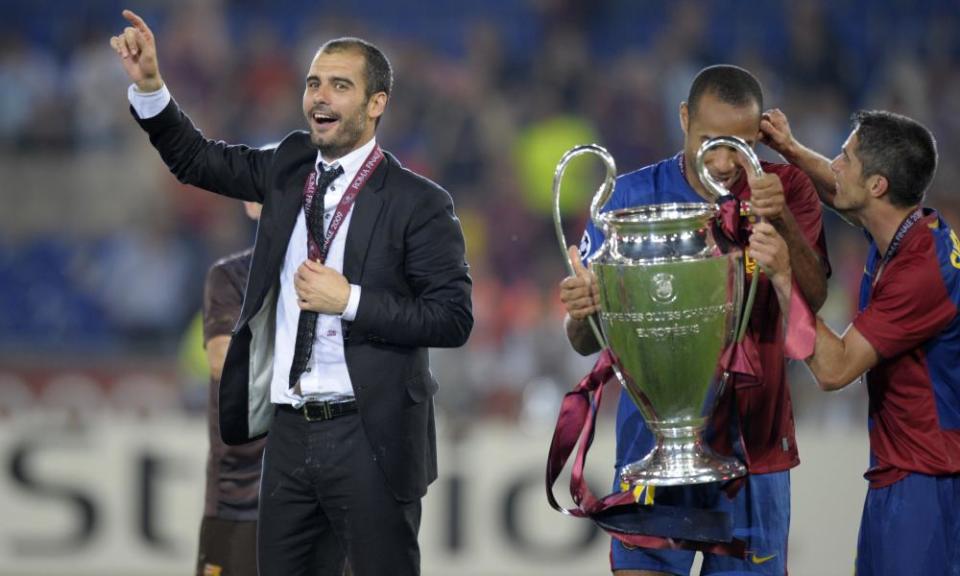Guardiola-Klopp tactical hybrid now dominates European football

Perhaps what has been most striking about this season from a tactical point of view has been the degree of consensus. Money can skew games and there always remains the possibility of a brilliant player upsetting theory by doing something brilliant, but for those clubs who have a notion of an underlying philosophy of play it’s fairly clear what that looks like: a high offside line, a coordinated press and a capacity to retain possession when required.
There has been a tendency to portray Pep Guardiola and Jürgen Klopp as opposite poles, one focused on retaining the ball and one on regaining it. That is not unreasonable, although each has edged towards the other over the past couple of seasons. Perhaps what is most significant is that nobody really questions the axis by which they are judged. The age of attrition, of Greece winning the Euros, of José Mourinho, Rafa Benítez and Alex Ferguson in the Carlos Queiroz years, feels a long time ago.
Related: Liverpool denied title but Paris can provide final flourish to superb season | Jonathan Wilson
Football changed in 2008, and not just because that was when Guardiola was appointed manager of Barcelona. Before then the knockout stage of the Champions League had only once yielded more than three goals per game; since then the average has only once dipped below three.
It was then that a number of factors came together. Improvements in pitch, kit and ball technology had, for some time, meant that at the highest level a first touch could be taken for granted. The liberalisation of the offside law pushed back defensive lines. Intimidatory tackling had largely been eliminated. That meant there was more space which allowed diminutive technical midfielders who might previously have been bullied out of the game to flourish.
Suddenly it became possible for the bigger teams, who were becoming relatively bigger than they ever had been before, to exercise greater control over games than ever before, to worry about manipulating space, Guardiola’s juego de posición, rather than having to scrap for midfield survival. That in turn led to significant discomfort when big sides met and one found itself unable to get the ball. One of the reasons Manchester United players lost discipline in the 2009 Champions League final was a sense of humiliation at having “only” around 40% possession.
The following year, Mourinho’s Internazionale would show it was possible to win (or at least to lose narrowly enough to win on aggregate) with just 19% possession. Sitting back, holding position, allowing the opposition the ball but only 30 yards or more from goal became a viable way to combat the possession sides. Football began to look at times like handball. But there was another way, which was that promulgated by Klopp, who disliked the passivity of bunkering down, hoping nobody pinged a long-range drive into the top corner or suddenly dribbled past three players to score. That was to press hard and high in a coordinated way and look for turnovers and rapid transitions.

Guardiola’s teams pressed but not with quite the same intensity or with quite the same immediate view to the counter. They would break if the opportunity was there, but if it wasn’t, Guardiola was perfectly happy for his sides to reset and begin the process again, something he said could take 15 passes. Guardiola was about control and Klopp about chaos.
But as Guardiola’s Champions League hopes have regularly been undone by opponents playing on the break, he has had to adjust to counter the counter. In part there seems a clear intention to retain five outfield players behind the ball at all times, but there is also more of a gegenpress, which in turn has increased City’s threat on the counter. Klopp, meanwhile, seeing the accumulated fatigue – physical and mental – of constant heavy-metal football, has taken steps to control games more, which was one of the drivers behind his signing of Thiago Alcântara, perhaps the most characteristic Guardiola player there is.
Thomas Tuchel, Antonio Conte, Stefano Pioli, Xavi, Julian Nagelsmann, Thomas Frank, Brendan Rodgers, Gian Piero Gasperini – the vast majority of modern managers lie at some point on the same spectrum. Exceptions, among top clubs, are rare and tend to be the result of a fascination with celebrity, often allied with grotesque mismanagement. Even had he had greater authority, Ralf Rangnick would have struggled with a squad struggling to accommodate Cristiano Ronaldo, whose destabilising presence at Juventus is a reason they have gone back to the familiar comforts of Max Allegri.
Real Madrid, so far, have been a fine example of how great players can suddenly turn games that seem to be going against them, but Paris Saint-Germain are the most interesting example of celebrity culture, the acquisition of a luxury front three necessitating the employment of a grimly industrial midfield that militates against fluency. The only real philosophical outlier is Diego Simeone at Atlético Madrid, although with each passing season the sense grows that that is a retro project of diminishing returns.
It’s rare in the modern game that the lines are so clear. Guardiola implemented a style of play that capitalised on changed conditions, Klopp found a way of countering it, Guardiola reacted and what has followed is a synthesis of gegenpressing and juego de posición.

 Yahoo Sport
Yahoo Sport 





































